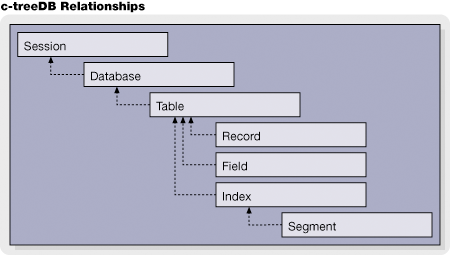Developer Guide |
|
FairCom DB API for C |
|
Audience: |
Developers |
Subject: |
FairCom DB API Navigational, Session-Oriented C API |
Copyright: |
© Copyright 2025, FairCom Corporation. All rights reserved. For full information, see the FairCom Copyright Notice. |
FairCom is pleased to present the FairCom database API — FairCom DB API. The FairCom DB API gives application developers a simple interface into the powerful core of c-tree database engine, yet includes the advanced functionality that distinguishes FairCom from other database solutions. The FairCom DB API offers a method of database creation and maintenance that is easier to use than the traditional FairCom DB ISAM and FairCom Low-Level APIs. The FairCom database utilizes the simplified concepts of sessions, databases, and tables in addition to the standard concepts of records, fields, indexes, and segments. This database API allows for effortless and productive management of database systems.
Overview
The FairCom DB API for C provides libraries that, once installed and correctly referenced, allow C programs to access the FairCom database core using function calls. The FairCom database API gives application developers a simple interface into the powerful core of the FairCom database, yet includes the advanced functionality that distinguishes FairCom from other database solutions. The FairCom DB API offers a method of database creation and maintenance that is easier to use than the traditional FairCom DB NoSQL (ISAM) and FairCom Low-Level APIs.

The FairCom DB API utilizes the simplified concepts of sessions, databases, and tables in addition to the standard concepts of records, fields, indices, and segments. This database layer allows for effortless and productive management of database systems.

The FairCom DB API consists of two separate APIs. The C++ API provides the classes and methods that comprise the database functionality. The C API provides the function calls without object-oriented schema. Aside from the schematic differences, there are few distinctions between the FairCom DB API for C++ and C.
Layout of this Manual
This documentation, which describes the FairCom DB API C API, is divided into the following major chapters:
Quick Tour
The quick tour section will show how easy it is to develop database applications using the FairCom DB API C API. Basically you should initialize, define, manage, and you are done. Please take a look at our introductory tutorials for a quick introduction into FairCom DB API database programming.
Programmer’s Reference
The programmer's reference presents a detailed description of the concepts exported by FairCom DB API C API. Each concept is presented with a detailed description and programming examples.
Function Reference
The function reference details the functions that comprise the FairCom DB API C API.
FairCom provides four quick tutorials for each supported API. These tutorials show the major components of our core technology:
You can find these tutorials in the ReadMe files for the FairCom DB API navigational interface:
FairCom DB API Interfaces for Other Languages
FairCom offers navigational interfaces for many languages.
Navigational record-oriented interfaces:
Language |
Notes |
Drivers Folder (V12 location) |
Nickname |
Record-oriented C API |
c.nav |
ctdb |
|
Record-oriented C++ API |
cpp.nav |
ctpp |
|
Record-oriented Microsoft C# .NET API |
csharp.nav |
|
|
Record-oriented Java API |
java.nav |
jtdb |
|
Java |
java.jpa.nav |
ctree.isam.jpa |
|
Record-oriented API for JavaScript |
nodejs.nav |
c-tree Node.js Module |
|
Record-oriented API for Python |
python.nav |
Python NAV |
|
Record-oriented API for Microsoft Visual Basic .NET |
vb.nav |
vtdb |
|
VCL |
Record-oriented API for VCL data components for Embarcadero Delphi |
(available from FairCom) |
dtdb |
You can find additional tutorials and information about the entire set of FairCom APIs in the following ReadMe:
The ReadMe files document the very basic tutorials packaged with the product. On the FairCom website you can find highly informative interactive tutorials:
These tutorials cover the major programming languages that FairCom DB API supports and go in depth to illustrate best practices for multi-threaded environments with SQL compatibility.